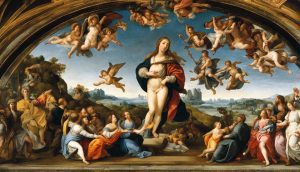Title of Artwork: “The Eiffel Tower”
Original Title: “La tour Eiffel”

Artwork by Georges Seurat
Year Created 1889
All About The Eiffel Tower by Georges Seurat
In the midst of Paris’s busy streets, in the year 1889, artist Georges Seurat unveiled his magnificent work, “The Eiffel Tower.” This famous piece of art was produced while the renowned tower was being built, and it has a special place in the annals of art. Seurat’s “The Eiffel Tower” is a well-known work of art thanks to his exacting technique, original use of pointillism, and ability to capture the essence of this engineering marvel.
Georges Seurat, a pioneer of the pointillist movement, used countless tiny dots of paint to create his masterpieces. Seurat painstakingly placed each dot to create a seamless image with an eye for colour theory and scientific accuracy. This method is best demonstrated in “The Eiffel Tower,” where Seurat expertly captures the interaction of light and shadow on the tower’s intricate iron structure. The meticulously placed dots give the painting a sense of depth and luminosity, as well as a distinct vibrancy and energy.
Seurat’s portrayal of the Eiffel Tower captures the spirit of the era in addition to his technical mastery. The tower, which was finished in time for the 1889 Exposition Universelle, symbolised the invention and development of the time. In Seurat’s depiction, the tower stands out dramatically against the backdrop of Paris, evoking the grandeur and ambition that went into its design. Seurat conveys the architectural beauty of the building as well as the era’s industrial spirit by using pointillism to capture the iron lattice and intricate details.
Seurat’s mastery of composition is also evident in “The Eiffel Tower”. The tower occupies the centre of the painting’s canvas, surrounded by the park’s lush vegetation and the animated figures of people taking in the view. The harmony and balance in Seurat’s composition help to focus the viewer’s attention on the main feature while also giving a glimpse of the bustling life that surrounds the monument.
Additionally, “The Eiffel Tower” marks a turning point in art history because Seurat’s avant-garde approach and portrayal of modernity paved the way for later movements in the arts. His meticulous attention to detail and careful dot placement, which are hallmarks of his pointillist style, had a major impact on later artists and helped post-impressionism and neo-impressionism to emerge.
Despite its age, “The Eiffel Tower” still draws viewers in with its stunning appearance and interesting past. The artwork serves as evidence of Seurat’s artistic genius, demonstrating his capacity to capture not only the external features of a scene but also its atmosphere and spirit. By taking viewers back to the 19th century and immersing them in the allure and wonder of the Eiffel Tower’s construction, it acts as a visual time capsule.
Finally, “The Eiffel Tower” by Georges Seurat is a magnificent work of art that perfectly captures the spirit of this engineering marvel. Seurat skillfully captures the play of light and shadow, the majesty of the tower, and the vibrant life around it using his unique pointillist technique. The painting not only captures the mood of the era, but also an important turning point in the development of art. It continues to enthral and inspire viewers today, serving as a monument to Seurat’s artistic brilliance and inviting us to appreciate the beauty of both the iconic building and the artist’s distinctive vision.
Recommend0 recommendationsPublished in Artworks





Responses